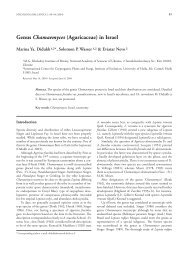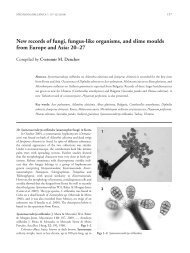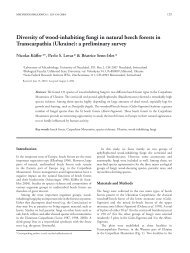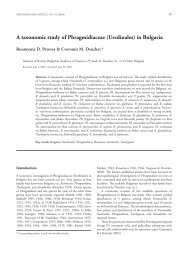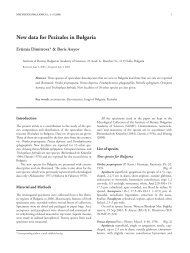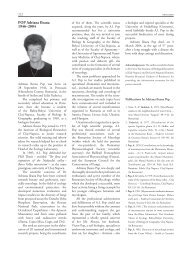Full text - Mycologia Balcanica
Full text - Mycologia Balcanica
Full text - Mycologia Balcanica
Create successful ePaper yourself
Turn your PDF publications into a flip-book with our unique Google optimized e-Paper software.
MYCOLOGIA BALCANICA 1: 61–62 (2004)<br />
61<br />
Occurrence of the araneogenous fungus Gibellula pulchra in<br />
Turkey<br />
Faruk Selçuk 1, Elşad Hüseyin 2* & Muhammet Gaffaroğlu 2<br />
1 Fırat University, Science and Arts Faculty, Department of Biology, 23169 Elazığ, Turkey<br />
2 Gazi University, Kırşehir Science and Arts Faculty, Department of Biology, 40200 Kırşehir, Turkey<br />
Received: April 10, 2003 / Accepted: August 29, 2003<br />
Abstract. The genus Gibellula is reported for the first time from Turkey. Gibellula pulchra on a spider is a new<br />
addition to the Turkish mycobiota. This fungus was found in a subtropical forest in canyons.<br />
Key words: fungi on spiders, Gibellula pulchra, new record, Turkish mycobiota<br />
Introduction<br />
Turkey, given its high diversity of vascular plants as well as insects<br />
and other arthropods, certainly has many species of fungi<br />
waiting to be discovered.<br />
The aim of our field work along the Black Sea coast in<br />
August 1999 was the investigation of microfungi with an emphasis<br />
on entomogenous species. Our attention was particularly<br />
attracted to a fungus on leaves of Buxus sempervirens L.<br />
Strangely, there was no leaf spot or destruction of the leaves<br />
and the fungus was not connected with a leaf tissue. The material<br />
was taken back and studied in the laboratory where it<br />
was found that the fungal colony was covering the body of a<br />
small spider. The spider was covered by a whitish brown curly<br />
mycelium. The parasite was identified as Gibellula pulchra<br />
(Sacc.) Cavara. The species and genus are reported here as new<br />
to Turkey.<br />
Materials and Methods<br />
* Corresponding author: e-mail: elsadhuseyin@hotmail.com<br />
The morphological characters of the Turkish specimen of<br />
Gibellula pulchra were examined by standard methods using<br />
an Olympus research microscope and available literature<br />
(Cavara 1894; Speare 1912; Petch 1932; Mains 1950; Morris<br />
1963; Samson & Evans 1973, 1992; Kobayasi & Shimizu<br />
1982; Evans & Samson 1987). The specimen has been deposited<br />
in the Herbarium of Gazi University, Kırşehir Sciences<br />
and Arts Faculty, Turkey.<br />
Results and Discussion<br />
The study clearly demonstrated that the fungus is a species of<br />
Gibellula, viz. G. pulchra.<br />
Gibellula pulchra (Sacc.) Cavara, Att. Instit. Bot. Univ. Pavia,<br />
Ser 2, 3: 347, 1894. (Fig. 1)<br />
Corethropsis pulchra Sacc., Michelia 1: 83, 1877. – Gibellula<br />
australis Speg., Ann. Soc. Cient. Arg. 13: 24, 1882. – G. suffulta<br />
Speare, Phytopathology 2: 137, 1912. – G. arachnophila<br />
Yohnston, Bul. Porto Rico Insular Exp. Sta. 10: 24, 1915<br />
not G. arachnophila (Ditm.) Vuill. 1911. – G. arachnophila<br />
f. macropus Vuill. in Maublanc, Bul. Soc. Mycol. France 36:<br />
41, 1920. – G. haygarthii Bijl, Trans. Roy. Soc. S. Africa 10:<br />
149, 1922. – G. aranearum Syd., Englers Bot. Jahrb. 62: 321,<br />
1922.<br />
Synnemata cylindrical, angustate to the apice, whitish<br />
brown, pinkish when dried, 1.5-3 mm long, 100-200 µmm<br />
thick below, 75-100 µmm thick above, composed of multiseptate,<br />
loosely bound, longitudinal, parallel, thin hyphae.<br />
Conidiophores arising from slightly brownish, asperulate hyphae,<br />
loosely attached to the surface of synnemata, 155-170<br />
µmm long, (6–) 7.5-10 µmm thick, the lower cells brownish,<br />
asperulate, the terminal cell or cells hyaline, smooth, 2.5-
62<br />
selçuk, f., hüseyin, e. & gaffaroğlu, m. — Gibellula pulchra in turkey<br />
Fig. 1. A mummifi ed<br />
body of a spider with<br />
a fruiting stalk. Bar =<br />
2 mm<br />
3 µmm thick below, apex enlarged into globose, obovoid or<br />
broadly-clavate vesicle, 7.5-10 µmm wide. Phialides cylindrical<br />
with a short neck, 6.2-7.5 × 5 µmm, borne on metulae.<br />
Metulae narrowly clavate, 7.5-8 × 1.5-2.5 µmm. Phialides and<br />
metulae on conidiophores forming spherical heads, 40-43<br />
µmm diam. Conidia fusiform to fusiform-ellipsoid, smoothwalled,<br />
3-5 × 1.5-2.5 µmm, produced in succession from the<br />
phialides, occuring singly or in short chains.<br />
On an unknown species of spider on leaves of Buxus sempervirens<br />
L. (Buxaceae). TURKEY: Rize Province, 3 km from<br />
Rize to Ayder, alt. 1750 m, 31 Jul 1999, F. Selçuk (Herb. Gazi<br />
University, Kırşehir, FS 0444).<br />
Species of the hyphomycetous genus Gibellula are highly<br />
specialized and apparently obligate parasites on spiders. In<br />
Turkey G. pulchra was found in subtropical forests in canyons.<br />
We were unable to find the teleomorph of this fungus,<br />
Torrubiella arachnophila (Johnst.) Mains var. pulchra Mains.<br />
Acknowledgements The authors wish to express their thanks for the financial<br />
support from TÜBİTAK (Project no. TOGTAG – TARP 2345). Dr. C.<br />
M. Denchev and the anonymous reviewers are thanked for critically reading<br />
the manuscript.<br />
References<br />
Cavara, F. 1894. Ulteriore contribuzione all Micologica Lombarda. – Atti<br />
Istituti Botanici Universita di Pavia, Ser. 2, 3: 313-350.<br />
Evans, H.C. & Samson, R.A. 1987. Fungal pathogens of spiders. – Mycologist<br />
1: 152-159.<br />
Kobayasi, Y. & Shimizu, D. 1982. Monograph of the genus Torrubiella. –<br />
Bulletin of National Science Museum, Tokyo, Ser. B, 8: 43-78.<br />
Mains, E.B. 1950. The genus Gibellula on spiders in North America. –<br />
<strong>Mycologia</strong> 42: 306-321.<br />
Morris, E.F. 1963. The synnematous genera of the Fungi Imperfecti. – Western<br />
Illinois University, Series in the Biological Sciences 3: 1-143.<br />
Petch, T. 1932. Gibellula. – Annales Mycologici 30: 386-393.<br />
Saccardo, P.A. 1877. Fungi Halici autographice delineati. – Michelia 1:<br />
73-100.<br />
Samson, R.A. & Evans, H.C. 1973. Notes on entomogenous fungi from Ghana<br />
I. The genera Gibellula and Pseudogibellula. – Acta Botanica Neerlandica<br />
22: 522-528.<br />
Samson, R.A. & Evans, H.C. 1992. New species of Gibellula on spiders<br />
(Araneida) from South America. – <strong>Mycologia</strong> 84: 300-314.<br />
Speare, A.T. 1912. Notes on Hawaiian fungi. I. Gibellula suffulta n. sp. –<br />
Phytopathology 2: 135-137.



